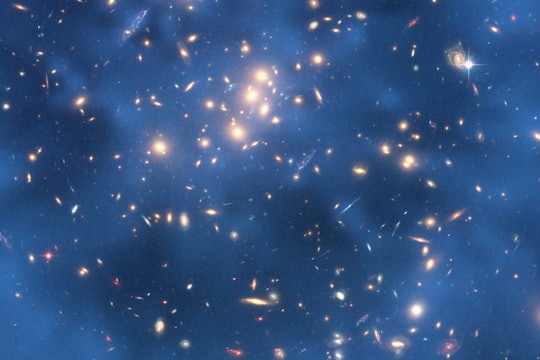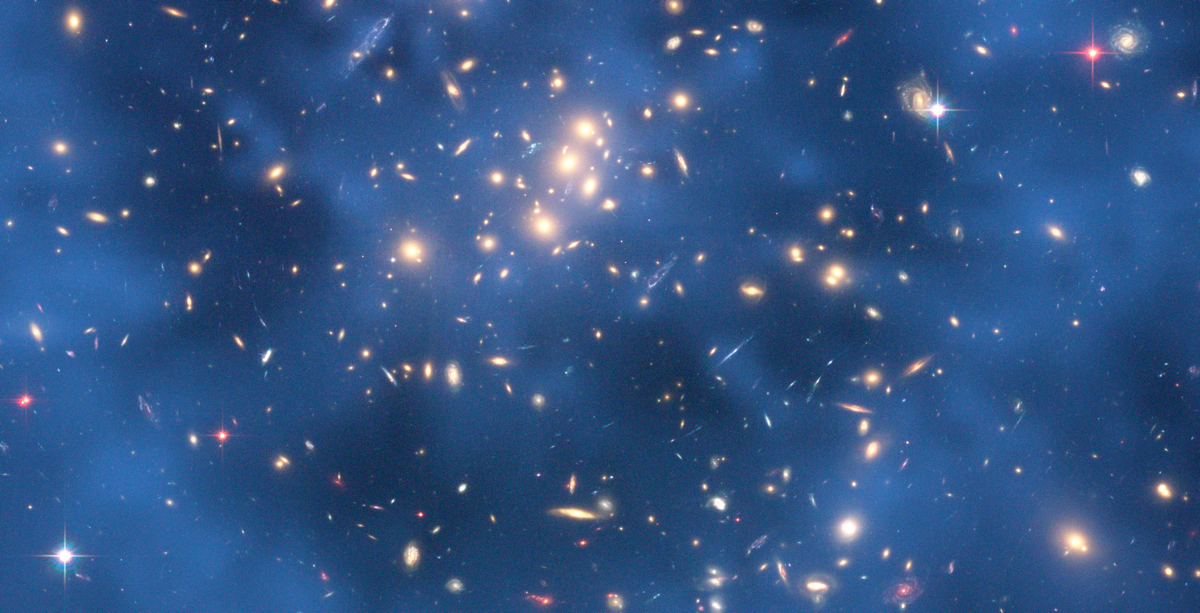

Produced in partnership with Science at Pioneer Works
Dark Matter makes up a quarter of our universe, but we still have no idea what it is
The discovery of the Higgs boson points us in the right direction, but we’re still feeling our way through the dark.
Our observable universe shines with the light of hundreds of billions of galaxies, each with hundreds of billions of stars, vast clouds of gas and dust, nebula cast off in explosions — a zoo of luminous objects. And while that might sound like a lot of stuff, everything we have ever seen constitutes less than 5% of what’s out there. Nearly 25% of the universe’s content hides in an unknown form: Dark Matter. Despite decades of effort to detect dark matter, the substance eludes us.
As a part of the Scientific Controversies series, theoretical cosmologist Sean Carroll, experimental particle physicist Melissa Franklin — who worked on the ATLAS experiment to test the Higgs boson theory at the Large Hadron Collider — and astrophysicist Janna Levin met on May 11, 2015 to discuss the discovery of the Higgs boson and how Dark Matter is in the sights of researchers at the LHC.

Janna L.: I want to ask, what now? I know you can keep looking at the Higgs and finding its details, but there must be another reason why the LHC is turning on at even higher energies and is going full throttle.
Melissa F.: We’re doing it because we can. We will study the Higgs. We’re getting a lot of money to do that. We will also look for dark matter.
Janna L.: Tell people what dark matter is.
Melissa F.: Dark matter is this stuff that we’ve seen out there, in the Universe, that doesn’t interact with light. It doesn’t give off light and it doesn’t eat light, but it bends light because it’s got a gravitational field. It’s massive. We’re trying to figure out what kind of particle that is. There’s a whole bunch of people underground all over the world looking for this. Going underground, we can talk about that, but it’s a good place to go. There’s a wind of dark matter going through the Earth. We might be able to see it. We also might be able to see it in the accelerator. We’re looking for that.
Janna L.: The dark matter’s also a huge amount of what we know to exist in the universe. What’s stunning about it is that we’re just a tiny bit of stuff. The protons, you, me, the Earth, everything we’ve ever seen basically in the universe is less than five percent of what makes up the universe. By far, the bulk is in something called dark energy, and there’s about 25% in dark matter? We only call it dark matter because we don’t know what else to call it.
Melissa F.: We’re the one percent.
Sean C.: Occupy the Universe, yes. The existence of this dark matter is the very, very strong evidence that we’re nowhere near done yet in finding particles. You could imagine that we live in the Universe where all of the particles that lasted more than a femtosecond, we’d already found. There’s the electron. There’s the protons. There’s the neutrons. We found them, they’re in our detectors. You could imagine a world in which there’s just nothing more to find that sticks around like that. We know that’s not our world. There’s all this other stuff out there, most of the mass in the Universe is dark. It’s not any of the particles in the standard model of particle physics. That sort of nightmarish scenario for physicists, where it’s going to be very hard to find new things, is probably not our universe. There’s something very blatantly out there. Whether we’ll be able to find it, we don’t know. We’re looking at the LHC, like Melissa says. We’re looking underground. We’re looking at the sky to see whether or not the dark matter might be doing something interesting, like annihilating and giving off high energy photons, or something like that. We know it’s there. We can make maps of it. We can see its effects on other stuff in the Universe. We are the Christmas lights on the tree of the Universe. We’re the part that shines, but we’re not most of the stuff there. This journey is very far from completed.

Janna L.: I said 25%, or a little less than that, is in the dark matter. The rest, by far the bulk, is in the dark energy — which again is just a name we give to something we have no idea what it is. It is the thing driving the universe to expand at an accelerated rate. Is there any hope that this is connected to the Higgs boson?
Sean C.: There’s hope. My suspicion, my theoretical guess which may or may not be right, is just that as interesting as the dark matter is, the dark energy is boring. The dark energy is just the energy of empty space. It’s not changing with time. It’s the same amount everywhere. I hope that’s wrong. It’s much more interesting to be changing all over the place. It looks kind of vanilla and boring.
Janna L.: What do you think, Melissa? Do you think it’s just an accident that we’re coming in on these kind of proportions of dark energy, dark matter, as if they’re not connected and totally disparate?
Melissa F.: I don’t really know anything about dark energy except that other fields of physics are taking our money. I don’t know anything. I know what it is, but I have no feel for it. I don’t know how to look for it myself.
Janna L.: I think that’s generally true. It is, in some sense, much more mysterious than the dark matter. We have candidates for dark matter that exist, like neutrinos. They exist. I’ve never seen anything like dark energy.
Sean C.: I think we have a much better idea in the sense of a model for what the dark energy is. It’s the vacuum energy. It’s the energy of empty space. It’s a very simple idea that fits all the data perfectly. It’s 98 years old. Einstein came up with it. We are hoping that it’s wrong because it’s so boring, but it could be right.
Janna L.: Do you think that the Higgs is going to be the portal to the dark matter?
Sean C.: That is the hope. The Higgs boson is special for many reasons. It’s the only particle like it that we have ever found. It’s the only particle that we think, as far as we know, is fundamental, is not made of other particles, that does not have any spin at all by itself, for example. For these reasons, the Higgs is kind of more sociable than other particles. It’s easier for the Higgs boson to talk to the dark matter than for the electron to talk to the dark matter. In terms of theorists writing down the space of possibilities, there’s all sorts of tantalizing possibilities for the dark matter to be interesting in and of itself. We talk about the dark matter particle. Maybe there’s 23 different kinds of dark matter particles, and there’s dark atoms and dark chemistry. We don’t know these things. We know it’s very different than ours, but maybe it’s complex. Maybe it talks to us. Maybe there’s a whole new dark physics that’ll keep us occupied for the next 250 years.
Melissa F.: Here’s the thing: supposing the Higgs decays to dark matter particles, what do you see?
Janna L.: That was exactly my next question.
Melissa F.: You see nothing. That’s why it’s really, really hard because it’s hard to look for nothing completely. Sometimes you say, “Oh, there’s nothing.” You look at all the Higgs decays into other things and you say, “Well, it’s not enough. Something’s missing.”
Janna L.: What are you going to look for?
Melissa F.: We can look for nothing. Especially if dark matter is created from something else, we look to see something and then nothing. The nothing is missing energy. It’s a really beautiful thing.
Sean C.: I see nothing all the time. I don’t see why this is such a big challenge. Every experiment I’ve done, I’ve seen nothing.
Melissa F.: That’s deep.
Janna Levin and physicists Elena Aprile and Peter Fisher will be discussing the current state of the search for dark matter at Scientific Controversies 9 on November 15, 2016. Sign up to attend in person at Pioneer Works in Brooklyn, or subscribe to be notified about live-streaming and other coverage of our hunt for dark matter.
